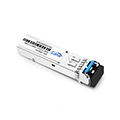Optical fiber can be divided into single-mode optical fiber and multi-mode optical fiber according to the number of transmission modes under its application wavelength. Due to the large core diameter, multimode optical fiber can be use with low cost light sources, so it has a very wide range of applications in short-distance transmission scenarios, such as data centers and LAN. With the rapid development of data center construction in recent years, multimode optical fiber, which is the mainstream of data center and LAN applications, has also attracted widespread attention.
Multimode Fiber Classification
According to the standard ISO/IEC 11801, multimode fibers are divided into five categories: OM1, OM2, OM3, OM4, and OM5, all of which belong to graded index multimode fibers. The corresponding relationship with IEC 60793 and the comparison of luminous size and bare fiber outer diameter are shown in Figure 1.“OM”stands for optical multi-mode, that is, optical mode, which is the standard for multimode fiber to indicate fiber grade.

Multimode Fiber Parameters
Bending capacity
There are many transmission modes in a multimode fiber, which brings the problem of fiber bending resistance. When the fiber is bent, high-order modes are easily leaked out, causing signal loss, that is, the bending loss of the fiber. With the increasing of indoor application scenarios, the wiring of multimode optical fibers in narrow environments has also put forward higher requirements for its bending resistance. The comparison of the bending resistance of the five types of optical fibers is shown in Figure 2.

Attenuation Coefficient
Fiber attenuation value is one of the most important characteristic parameters of multimode fiber, which determines the relay distance of multimode fiber to a large extent. It is mainly affected by the inherent loss, bending loss, impurity absorption and uniformity of the material. The comparison of the attenuation values of five types of common multimode fibers is shown in Figure 3.

Full Injection Bandwidth & Link Length
Traditional OM1 and OM2 multimode fibers are based on LED(Light Emitting Diode) in standard and design, OM3 and OM4 are optimized on the basis of OM2, making them suitable for LD(Laser Diode) at the same time. Compared with OM1 and OM2, OM3 has a higher transmission rate and bandwidth, and OM4 has better performance than OM3. OM5 fiber optical patch cord is optimized in the manufacturing process of the fiber perform, so it can support a higher bandwidth. In terms of structure, it is the same as OM3 and OM4 fiber optical patch cord, so it can be fully backward compatible with traditional OM3 and OM4 multimode optical fiber patch cord. With the continuous iterative upgrade of technology, the full injection bandwidth of multimode fibers has been increasing, and the link lengths are also different. The comparison of the attenuation coefficients and link lengths of the five commonly used multimode fibers in shown in Figure 4.

With the demand for applications continues to increase, multi-mode optical fiber is developing in the direction of low bending loss, high bandwidth, and multi-wavelength multiplexing. In the future, industry applications will have more and more demand for multi-mode optical fiber. JFOPT will continue to promote the use of cutting-edge multimode fiber optic solutions based on customer needs, bringing new breakthroughs and lower costs to data centers, fiber optic interconnection and other industries.














































































 Ann
Ann












